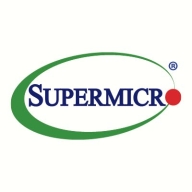

HPE BladeSystem and Supermicro SuperBlade are two products competing in the blade server market. HPE BladeSystem holds an advantage with its cost-effectiveness and reliability, while Supermicro SuperBlade shines with superior technology and performance for intensive computing environments.
Features: HPE BladeSystem is known for its modular design, efficient energy use, and robust management capabilities, making it easy to integrate with existing infrastructures. Supermicro SuperBlade offers exceptional computational power, flexibility, and advanced technology integration, ideal for tech-heavy environments requiring high processing power and scalability.
Room for Improvement: HPE BladeSystem could enhance its high-performance computing capabilities, improve flexibility, and adopt more advanced technology integrations. Supermicro SuperBlade could benefit from reduced deployment complexity, optimized energy efficiency, and enhanced support systems for easier integration.
Ease of Deployment and Customer Service: HPE BladeSystem offers straightforward deployment and comprehensive support services to ensure easy integration into enterprise systems. Supermicro SuperBlade, although sophisticated and performance-oriented, can require longer deployment times due to advanced configuration needs, but it provides detailed setup guides and responsive assistance.
Pricing and ROI: HPE BladeSystem's competitive initial setup costs and quick return on investment appeal to budget-sensitive businesses. Conversely, Supermicro SuperBlade necessitates a higher initial investment but promises substantial long-term benefits through superior performance and capability, making it attractive for organizations focusing on powerful computing solutions.
| Product | Market Share (%) |
|---|---|
| HPE BladeSystem | 12.9% |
| Supermicro SuperBlade | 7.9% |
| Other | 79.2% |


| Company Size | Count |
|---|---|
| Small Business | 29 |
| Midsize Enterprise | 40 |
| Large Enterprise | 103 |
HP ProLiant BladeSystem share power, cooling, network, and storage infrastructure via the blade enclosure. Since equipment is not needed for each server, you get a dramatic reduction in power distribution units, power cables, LAN and SAN switches, connectors, adapters, and cables. And you can add the newest-generation technologies by simply changing individual components.
Supermicro SuperBlade delivers innovative computing performance and efficiency, perfect for data-intensive tasks. With its modular design, it optimizes space and power, providing a flexible and scalable infrastructure for demanding business workloads.
Supermicro SuperBlade is specifically engineered for modern data centers needing high-density computing. It offers a compact, modular architecture that simplifies system management and enhances agility. It integrates seamlessly with cloud and virtualization technologies, supporting diverse applications and workloads. Its design focuses on reducing operational costs while achieving peak performance. Users appreciate its balance of power efficiency and high computing capacity.
What are the key features of Supermicro SuperBlade?Supermicro SuperBlade is widely implemented in sectors such as finance, healthcare, and research where high computational power and storage are critical. In finance, it's used for real-time analytics and transactions. Healthcare facilities use it for patient data analysis and complex simulations, while research institutions leverage SuperBlade for simulations and data-intensive research tasks. Its adaptability allows enterprises to efficiently meet technical requirements unique to each industry.
We monitor all Blade Servers reviews to prevent fraudulent reviews and keep review quality high. We do not post reviews by company employees or direct competitors. We validate each review for authenticity via cross-reference with LinkedIn, and personal follow-up with the reviewer when necessary.